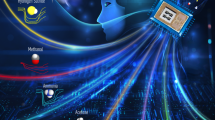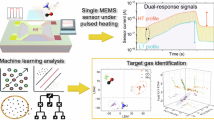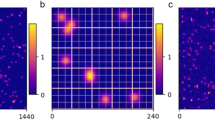Abstract
THERE is much interest in the use of chemical sensor arrays, in conjunction with pattern-recognition routines, for developing artificial olfactory devices—'electronic noses'—which can characterize the chemical composition of gas mixtures1–5. Here we describe a technique that uses a continuous sensing surface and a detection method involving a scanning pulsed light source, to generate images that represent a fingerprint of the gases detected. The detector is a large-area field-effect device with a number of different catalytic metals constituting the detecting surface (the device's active gate) 6,7. A pulsed light beam scanned across this surface generates a photocapacitive current that varies with the value of the surface potential8,9. A continuous sensing surface of this type provides information that would require an array of hundreds of discrete sensors. The technique also provides a new means of studying the coupling between the electronic properties of catalytic metals and chemical reactions taking place on their surfaces.
This is a preview of subscription content, access via your institution
Access options
Subscribe to this journal
Receive 51 print issues and online access
$199.00 per year
only $3.90 per issue
Buy this article
- Purchase on SpringerLink
- Instant access to full article PDF
Prices may be subject to local taxes which are calculated during checkout
Similar content being viewed by others
References
Carey, W. P., Beebe, K. R., Kowalski, B. R., Illman, D. L. & Hirschfeld, T. Analyt. Chem. 58, 149–153 (1986).
Müller, R. & Lange, E. Sensors Actuators 9, 39–48 (1986).
Kaneyasu, M., Ikegami, A., Arima, H. & Iwanaga, S. IEEE Trans. Components, Hybrids Manufact. Technol. CHMT-10, 267–273 (1987).
Shurmer, H. V. IEE Proc. G137, 197–204 (1990).
Gardner, J. W., Hines, E. L. & Wilkinson, M. Meas. Sci. Technol. 1, 446–452 (1990).
Lundström, I., Armgarth, M. & Petersson, L.-G. CRC Critical Rev. Solid St. Mater. Sci. 15, 201–278 (1989).
Lundström, I., Spetz, A., Winquist, F., Ackelid, U. & Sundgren, H. Sensors Actuators B1, 15–20 (1990).
DiStefano, T. H. & Viggiano, V. M. IBM J. Res. Dev. 18, 94–99 (1974).
Engström, O. & Carlsson, A. J. appl. Phys. 54, 5245–5251 (1983).
Winquist, F. & Lundström, I. Sensors Actuators 12, 255–261 (1987).
Sundgren, H. et al. Sensors Actuators B1, 473–476 (1990).
Sundgren, H., Winquist, F., Lukkari, I. & Lundström, I. Meas. Sci. Technol. 2, 464–469 (1991).
Hafeman, D. G., Parce, J. W. & McConnell, H. M. Science 240, 1182–1185 (1988).
Parce, J. W. et al. Science 246, 243–247 (1989).
Erlandsson, R., Wigren, R. & Olsson, L. Microsc. Microanal. Microstruct. (in the press).
Rotermund, H. H., Engel, W., Kordesch, M. & Ertl, G. Nature 243, 355–357 (1990).
Schild, D. Biophys. J. 54, 1001–1011 (1988).
Author information
Authors and Affiliations
Rights and permissions
About this article
Cite this article
Lundström, I., Erlandsson, R., Frykman, U. et al. Artificial 'olfactory' images from a chemical sensor using a light-pulse technique. Nature 352, 47–50 (1991). https://doi.org/10.1038/352047a0
Received:
Accepted:
Issue date:
DOI: https://doi.org/10.1038/352047a0
This article is cited by
-
Evaluation of quantum dots applied as switchable layer in a light-controlled electrochemical sensor
Analytical and Bioanalytical Chemistry (2010)
-
Picture the smell
Nature (2000)
-
A chemical-detecting system based on a cross-reactive optical sensor array
Nature (1996)



